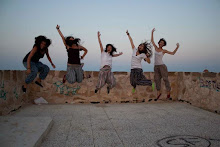Fogue Res 2012
In lieu of Forth of July, we here in Spain get to be witnesses and spectators of the bonfires of Saint John. As it turns out, all of Europe celebrates the Summer Solstice, the longest day of the year and the first day of summer. People all over have bonfires on the beach. It is a revival of a long tradition dating back to the pagan roots which are much deeper here than back home. Either way, Alicante uses this tradition in a ridiculous and rare fashion. The day of bonfires has metamorphosed into a two week long festival with two types of firework displays, bull fights, food, parades, floats, and dance parties.
In lieu of Forth of July, we here in Spain get to be witnesses and spectators of the bonfires of Saint John. As it turns out, all of Europe celebrates the Summer Solstice, the longest day of the year and the first day of summer. People all over have bonfires on the beach. It is a revival of a long tradition dating back to the pagan roots which are much deeper here than back home. Either way, Alicante uses this tradition in a ridiculous and rare fashion. The day of bonfires has metamorphosed into a two week long festival with two types of firework displays, bull fights, food, parades, floats, and dance parties.
There are two types of fireworks, the masculine and the feminine.
The masculine is during the day at 2pm of the first week. It is a show of
noise. Everyone gathers as close as they can to the display and gets
overwhelmed by the explosions as a sound concert. It goes into your bones, and
deep into your chest. Those who designed the display make a rhythm of canon
fire. They play with the height of the fireworks to affect the sound and the
layering of explosions. Everyone is excited and facing the square, however
there is nothing to see only hear and feel.
On the second week are the feminine fireworks. They begin at
midnight (the time when people start going out at night here) on the beach.
Everyone sits with their family and friends and make mounds of sand within
which to sit and gaze at the fireworks. And they are works of art. There is a
soft display followed by a pause and a bit more intense display and pause with
canon echoing off large apartment buildings back to you again and then another
soft display. The buildup is not continuous; it goes back and forth and back
and forth playing with you. The funny thing is, you can’t hear it. They are
huge displays of light, with little to no sound. The canons are a crack with a
bright white light that fills the sky for a split second, yet the sound does
not match.
It is almost as if the Spanish here took our understanding of
fireworks and separated them into two different parts. It doesn’t make any
sense, but then again it is more intentional and thought-out than any fireworks
display I have ever seen in my life: a wonderful show of color and light, noise
and intensity.
In between the two weeks of firework is the burning of
effigies. There are 86 or so communities or neighborhoods or streets which
organize themselves and compete for the best float. On one night, they all get
burned. It starts at midnight with the one in front of the town hall. After which
it is a mad race to find out when and where there will be another event. Random
and nonsensical, the people of Alicante sing and dance while those attending
the fire hose down buildings and onlookers to keep them from getting too hot.
In front of the city hall, the flames go higher than the 5 storey buildings
only 30 feet away. People down wind, be advised! Huge speakers are placed right
at ground zero and are covered with tarps. The people in the front taunt the
firemen to hose them down while the anticipation builds. After the effigy is
lit and burning the music breaks out and dancing and singing fill the narrow streets.
Epic.
Effigy of Dali
City Hall, pre-bonfire
-Alaska



No comments:
Post a Comment